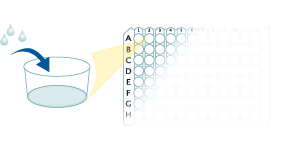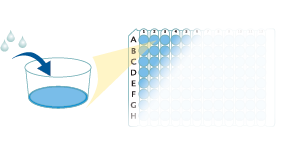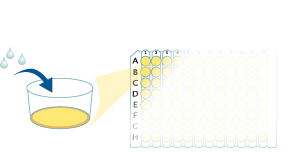Background: Endothelin-1
Endothelin-1 (ET-1), a peptide of 21 amino acid (aa) residues, is a pleiotropic molecule best known for its action as a potent vasoconstrictor (1). Originally isolated from porcine aortic endothelial cells, ET-1 is one of a family of three proteins encoded by distinct genes that also includes Endothelin-2 (ET-2) and Endothelin-3 (ET-3) (2, 3). ET-2 and ET-3 differ from ET-1 by 2 and 6 amino acids, respectively (1, 2). All members of the Endothelin family contain two essential disulfide bridges and six conserved aa residues at the C-terminus. Human ET-1 is initially synthesized as a pre-pro-polypeptide of 212 amino acids (2, 4). It is proteolytically cleaved by a signal peptidase to produce pro-ET-1 and further processed by a Furin-like protease to yield a 38 aa peptide termed Big ET-1 (5, 6). Big ET-1 is then cleaved by the membrane-bound metalloprotease Endothelin-converting enzyme (ECE-1), producing the potent 21 aa mature form ET-1 (aa 1-21) (7, 8). Alternatively, ET-1 may exist in an active 31 aa form (ET-1 (aa 1-31)) following cleavage of Big ET-1 by chymase (9-12). The vascular endothelium is an abundant source of ET-1 (3, 13). It may also be expressed by leukocytes, smooth muscle cells, mesangial cells, cardiac myocytes, and astrocytes (14, 15). ET-1 can be induced in endothelial cells by many factors including mechanical stimulation, various hormones, and pro-inflammatory cytokines (16). Production is inhibited by nitric oxide (NO), Prostacyclin, and atrial natriuretic peptide (ANP) (17-19).
Two receptors for the Endothelin family have been cloned and designated ETA and ETB (20-23). ETA and ETB belong to the large family of heptahelical G protein-coupled receptors. The ETA receptor shows a higher affinity for ET-1 than for ET-2 and lowest affinity for ET-3, while the ETB receptor shows approximately equal affinity for each of the three Endothelins (21, 22, 24). ETA is primarily responsible for the vasoconstrictor effects of ET-1 and is expressed by blood vessel smooth muscle cells (25, 26). The ETB receptor is also present in smooth muscle and the endothelia of blood vessels, kidney, lung, and brain (27). ET-1 has the ability to activate an array of signaling cascades including classical phosphatidylinositol turnover pathways leading to downstream PKC activation and Ca2+ mobilization (28-32). Other potential signaling mediators activated or produced by ET-1 include PI 3-kinase/Akt, NO, FAK, and Rho GTPases (32-37). ET-1 signaling may also be mediated indirectly via transactivation of the EGF receptor leading to downstream signaling by Ras and MAP kinases (38, 39). Injection of a single dose of ET-1 produces an initial decrease in systemic blood pressure followed by a prolonged increase in blood pressure (16, 40, 41). Blockade of Endothelin receptors with a systemic injection of an ETA/ETB antagonist causes progressive vasodilation, and elevated levels of ET-1 are found in some forms of human hypertension (42, 43). ET-1 also stimulates cardiac contraction and the growth of cardiac myocytes, regulates the release of vasoactive substances, and stimulates smooth muscle cell mitogenesis (32, 44-46). It also acts as a pro-survival factor for endothelial cells and regulates secretion by hypothalamic and pituitary cells (47, 48). ET-1 may control inflammatory responses by promoting the adhesion and migration of neutrophils and stimulating the production of pro-inflammatory cytokines (49-53). It has also been implicated in cancer progression at several levels including regulating the proliferation and migration of tumor cells and acting as a pro-angiogenic factor (54, 55). In addition, ET-1 has putative roles in other pathologies including septic shock, atherosclerosis, heart failure, renal insufficiency, pulmonary hypertension, and cerebrovascular conditions associated with subarachnoid hemorrhage (15, 56-63).
Entrez Gene IDs:
1906 (Human); 13614 (Mouse); 24323 (Rat)
Alternate Names:
ARCND3; EDN1; endothelin 1; Endothelin-1; ET1; HDLCQ7; PPET1; preproendothelin-1; QME
 全部商品分类
全部商品分类



 下载产品说明书
下载产品说明书 下载SDS
下载SDS 用小程序,查商品更便捷
用小程序,查商品更便捷


 收藏
收藏
 对比
对比 咨询
咨询











